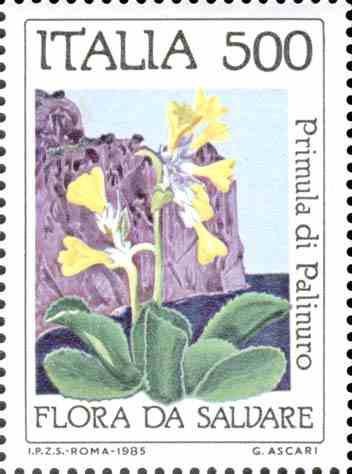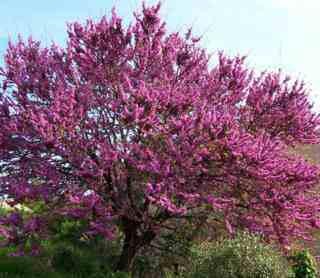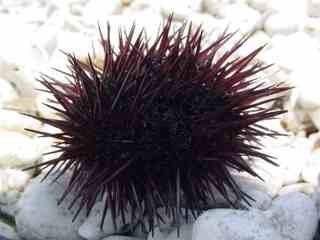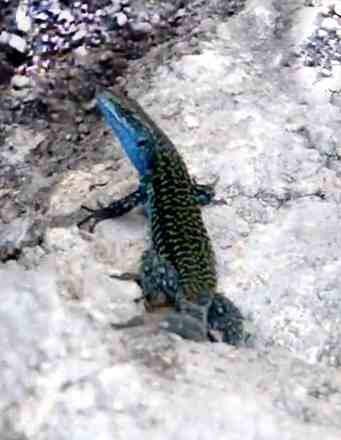Fauna and flora of the Maratea Coast
The plant and animal populations of the coast of Maratea
The primrose Palinuri Petagna is the most important endemism of the coast of Maratea and together with the so-called Dragon Santo Janni (the Podarcis siculus paulae, a reddish-blue lizard), the peregrine falcon and the thermo-Mediterranean shrublands represent the elements of the ecosystem more important to safeguard.

The primrose Palinuri Petagna
The flowering takes place between February and March, just as the other local species are still in vegetative rest, with beautiful and truly unique semi-pendulum flowers white / yellow, joined in umbrellas.
The plant reaches a maximum height of 12 cm with a maximum diameter of 25 cm, with leaves having toothed edges and an egg-shaped profile, grouped in rosettes.
The Primula Palinuri Petagna is located in rare locations along the coast stretch that begins from Cape Palinuro and extends across the Gulf of Policastro.
The Flora
The spontaneous flora of the Maratea coast is typically the Mediterranean spot, consisting mainly of Fillirea, Lentisco, Cisti, Mirto, Corbezzolo, Carpinella and Siliquastro, also known as the Tree of Judas.
The slopes are characterized by terraced wrecks demarcated by dry stone walls, which house carobs, figs, olive trees, vines, terebinth and the unmistakable wild fennel. Among the other plants of the scrub, the Ampelodesmus mauritanucus, stands out in the local language "tagliamani", used for the creation of "libani" or "libbani", vegetable ropes for fishing and for various other uses.
In the cavities of the walls, however, we find rare miniature specimens of Aleppo pines, while the figs of India, besides growing spontaneously, are used as a delimitation of cultivated plots, as is the case with agaves and bougainvillea.
Near the coast there are ancient junipers, pink flower cysts, yellow-orange poppy and arboreal euphoria. In the central part of the coastal strip spontaneously blossoms the rare dwarf palm (called Palma di S. Pietro).

The Fauna

The fauna is that of the rocky sea coast: in particular there is the real gull, the pilgrim falcon, the pale swallow, and finally the lonely sparrow of the blue livery.
The cliff fauna is varied and consisted, consisting of crabs, polyps, mussels and patelles and finally sea urchins; Deeper in the bottom bass are frequent sea stars and red sea tomatoes and further off the gorgonie.
The seabed
Particularly in the area of Marina and Punta Caina there are beautiful prairies of Poseidonea oceanica while in the area of Ogliastro you can appreciate the tiny small orange flowers of the madrepora Astroides calycularis.
The deep depths are the realm of breams, daggers, lizards, bavas, saraghs and rare species such as Nacchera, Sarago beaded, Ricciola, Sea ears, Alicia mirabilis, Pagur bernard, Madrepora Mediterranean pillow, the orange pillow and the common navy turtle (the famous Caretta caretta).
Lastly, the vast variety of rocky backdrops is the ideal habitat for the increasingly rare Brown Cernia, whose characteristic is to find the deep-deep den, the object of the desire and the appalling challenge for fishermen in apnea.
Edited by Jean Marout
Santo Janni Dragon
The Santo Janni Dragon or Podarcis siculus paulae is a brown-blue lizard, subspecies of the Podarcis siculus and is present as an endemism on the islet of Santojanni in Maratea.
It was recognized as endemism and therefore as a separate subspecies in 1971 in a study published in 1971 by Professor Benedetto Lanza and by Giuseppe Adeiani and Massimo Romiti, of the Institute of Zoology of the University of Florence.
Named "paulae" in honor of Mrs Paola Giorgio Lanza, this subspecies of Podarcis siculus differs from similar endemics, such as the "Podarcis siculus coerulea" which lives on the Faraglioni near Capri, due to its smaller dimensions (maximum length of the head and body of 71 mm instead of 87), the absence of scutum massetericum (a bony structure present in the head of some reptiles, in particular in lizards, consisting of a bony protrusion that extends from the skull and articulates with the mandible, providing an insertion point for the masseter muscles, those of mastication) and finally for the lighter dorsal background color.

www.maratea.info is managed by
AltriTurismi ets Association
-
Support our Association MAKE A DONATION !



